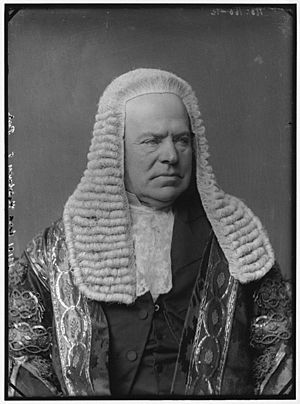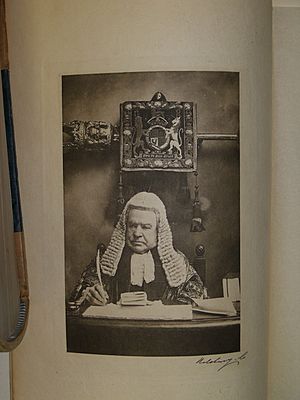Hardinge Giffard, 1st Earl of Halsbury facts for kids
Quick facts for kids
The Earl of Halsbury
|
|
|---|---|
 |
|
| Lord High Chancellor of Great Britain Lord High Steward for the trial of: List
The Earl Russell
|
|
| In office 24 June 1885 – 28 January 1886 |
|
| Prime Minister | The Marquess of Salisbury |
| Preceded by | The Earl of Selborne |
| Succeeded by | The Lord Herschell |
| In office 3 August 1886 – 11 August 1892 |
|
| Prime Minister | The Marquess of Salisbury |
| Preceded by | The Lord Herschell |
| Succeeded by | The Lord Herschell |
| In office 29 June 1895 – 4 December 1905 |
|
| Prime Minister | The Marquess of Salisbury Arthur Balfour |
| Preceded by | The Lord Herschell |
| Succeeded by | The Lord Loreburn |
| Personal details | |
| Born | 3 September 1823 Pentonville, London |
| Died | 11 December 1921 (aged 98) |
| Nationality | British |
| Political party | Conservative |
| Spouses |
Caroline Humphreys
(m. 1852; died 1873)Wilhelmina Woodfall
(m. 1874) |
| Children | Hardinge Goulburn Giffard, 2nd Earl of Halsbury |
| Parent |
|
| Alma mater | Merton College, Oxford |
Hardinge Stanley Giffard, 1st Earl of Halsbury (born 3 September 1823 – died 11 December 1921) was an important British lawyer and politician. He was a member of the Conservative Party. He served three times as the Lord High Chancellor of Great Britain, which is a very senior legal and political role. He held this position for a total of seventeen years.
Contents
A Young Life in London
Hardinge Giffard was born in Pentonville, London. He was the third son of Stanley Lees Giffard, who was an editor for the London Evening Standard newspaper. His mother, Susanna, was from County Mayo in Ireland.
Hardinge's mother passed away when he was only five years old. His father later married his cousin, Mary Anne Giffard. Hardinge was taught at home by his father for a while. After that, he went to Merton College, Oxford, a famous university. He finished his degree in 1845. From 1845 to 1848, he helped his father edit the Standard newspaper.
Becoming a Lawyer
In 1848, Hardinge Giffard began studying law at the Inner Temple in London. This is one of the four Inns of Court where barristers are trained. He officially became a barrister in 1850.
He worked on many important cases during his career. He was involved in famous trials like the Tichborne case. In 1865, he became a Queen's Counsel, which is a special title for experienced lawyers. He was also a bencher of the Inner Temple, a senior member who helps run the institution.
From 1883 to 1919, he held the honorary role of constable of Launceston Castle. This appointment was given to him by King Edward VII.
A Career in Politics
Hardinge Giffard tried to become a Member of Parliament (MP) for Cardiff twice, in 1868 and 1874. However, he did not win a seat.
In 1875, he was appointed Solicitor General by the Prime Minister, Benjamin Disraeli. This is a senior legal role in the government. He also received a knighthood, which meant he was called "Sir Hardinge Giffard." He finally became an MP for Launceston in 1877. He represented this area until he became a peer.
In 1885, Giffard was chosen to be the Lord High Chancellor of Great Britain. This is one of the highest legal offices in the UK. When he took this role, he was given the title Baron Halsbury. He held this important position three times:
- From 1885 to 1886
- From 1886 to 1892
- From 1895 to 1905
His time as Lord Chancellor was longer than almost anyone else's in history. In 1898, he was given an even higher title: Earl of Halsbury.
Lord Halsbury played a role in legal decisions that affected trade unions. These decisions, like the Taff Vale Rly Co v Amalgamated Society of Rly Servants case, influenced how unions could act. These legal challenges encouraged unions to seek more representation in Parliament, which helped lead to the formation of the Labour Party.
He was also involved in a big political debate in 1911 about the Parliament Act 1911. This law aimed to limit the power of the House of Lords. Lord Halsbury was a leader among those who strongly opposed the bill.
Beyond his legal and political work, Lord Halsbury held several other important positions. He was the President of the Royal Society of Literature. He was also a Grand Warden of English Freemasons and the High Steward of the University of Oxford.
Halsbury's Laws of England
One of Lord Halsbury's most lasting achievements was leading the creation of "Halsbury's Laws of England". This massive collection of books, published between 1907 and 1917, is a complete guide to English law. It is still a very important reference for lawyers today.
Later, other similar legal reference works followed, such as "Halsbury's Statutes" (1929) and "Halsbury's Statutory Instruments". These books are essential tools for understanding the laws of England.
Family Life
Lord Halsbury was married twice. His first wife was Caroline Humphreys, whom he married in 1852. They did not have any children, and Caroline passed away in 1873.
In 1874, he married Wilhelmina Woodfall. They had one son, Hardinge Goulburn Giffard, who later became the 2nd Earl of Halsbury. Lord Halsbury lived to be 98 years old, passing away in December 1921. His wife, the Countess of Halsbury, died in December 1927.
Notable Legal Cases
Here are some of the important cases where Lord Halsbury delivered judgment:
- Salomon v Salomon
- Mogul Steamship Co Ltd v McGregor, Gow & Co [1892] AC 25
- British South Africa Co v Companhia de Moçambique [1893] AC 602
- Bray v Ford [1896] AC 44
- Taff Vale Railway Co v Amalgamated Society of Railway Servants [1901] AC 426
- Daimler Co Ltd v Continental Tyre and Rubber Co (Great Britain) Ltd [1916] 2 AC 307
Images for kids



